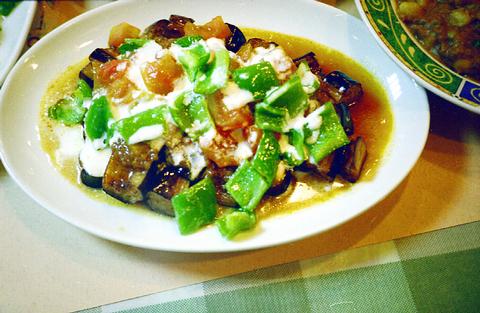If you're looking for a delicious, moderately-priced Indian restaurant where you can fill the table with a bumper crop of masalas, chick peas, curries and nan (Indian style unleavened bread), Kunming is one of the best in Taipei. The restaurant offers classic recipes from India, the Middle East and parts of Southeast Asia, giving stiff competition to the best dishes at any of Taipei's other Indian restaurants.
The prices at Kunming are an extra bonus. Vegetable plates, salads and hummus begin at NT$120, with more expensive dishes like Tandoori chicken topping out the menu at NT$250. Even the biggest feasts (it's best to go with a few people) seldom produce a bill that exceeds NT$350 a person, which is a bargain compared to the NT$600 or more one would have to pay for a similar meal elsewhere.
The musakka (NT$240) is exceptionally good. A Turkish recipe, the dish consists primarily of finely-ground beef that is seasoned and cooked with eggplant. The platter is then topped with green peppers, tomatoes and a trace of yogurt sauce. Samosas (NT$120), an appetizer of fried pastries stuffed with vegetables and served with sauce, are likewise delicious. Indian milk tea (NT$50) serves as a perfect cap to any meal.

PHOTO: DAVID FRAZIER, TAIPEI TIMES
Kunming is run by Yacoob Mah (馬雲昌) whose family originally hails from Yunnan, but was forced to flee to Burma in World War II and eventually made it to Taiwan 20 years ago. The family then opened its restaurant using a mix of recipes acquired over the years.
The only area in which Kunming could be said to be lacking is in its decor. The carved-wood furniture, the odd lamps and other elements associated with Indian dining rooms are not to be found. Instead, the interior lends itself more to the slightly drab non-style of mid-range Taiwanese eateries, with the addition of minor touches, like a large picture of the Taj Mahal on one of the concrete walls.
Even so, the general atmosphere is comfortable, and the owner is apt to play the genial host. Repeat customers are often greeted with a smile and sometimes rewarded for their patronage.

May 11 to May 18 The original Taichung Railway Station was long thought to have been completely razed. Opening on May 15, 1905, the one-story wooden structure soon outgrew its purpose and was replaced in 1917 by a grandiose, Western-style station. During construction on the third-generation station in 2017, workers discovered the service pit for the original station’s locomotive depot. A year later, a small wooden building on site was determined by historians to be the first stationmaster’s office, built around 1908. With these findings, the Taichung Railway Station Cultural Park now boasts that it has

The latest Formosa poll released at the end of last month shows confidence in President William Lai (賴清德) plunged 8.1 percent, while satisfaction with the Lai administration fared worse with a drop of 8.5 percent. Those lacking confidence in Lai jumped by 6 percent and dissatisfaction in his administration spiked up 6.7 percent. Confidence in Lai is still strong at 48.6 percent, compared to 43 percent lacking confidence — but this is his worst result overall since he took office. For the first time, dissatisfaction with his administration surpassed satisfaction, 47.3 to 47.1 percent. Though statistically a tie, for most

In February of this year the Taipei Times reported on the visit of Lienchiang County Commissioner Wang Chung-ming (王忠銘) of the Chinese Nationalist Party (KMT) and a delegation to a lantern festival in Fuzhou’s Mawei District in Fujian Province. “Today, Mawei and Matsu jointly marked the lantern festival,” Wang was quoted as saying, adding that both sides “being of one people,” is a cause for joy. Wang was passing around a common claim of officials of the People’s Republic of China (PRC) and the PRC’s allies and supporters in Taiwan — KMT and the Taiwan People’s Party — and elsewhere: Taiwan and

Six weeks before I embarked on a research mission in Kyoto, I was sitting alone at a bar counter in Melbourne. Next to me, a woman was bragging loudly to a friend: She, too, was heading to Kyoto, I quickly discerned. Except her trip was in four months. And she’d just pulled an all-nighter booking restaurant reservations. As I snooped on the conversation, I broke out in a sweat, panicking because I’d yet to secure a single table. Then I remembered: Eating well in Japan is absolutely not something to lose sleep over. It’s true that the best-known institutions book up faster